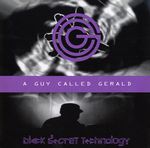 |
A Guy Called Gerald: Black Secret Technology (2008 Remaster) Album Review |
 |
Pitchfork 13th January 2009 Link |
| A Guy Called Gerald Black Secret Technology [Juice Box; 1995/2008] 8.7 / 10 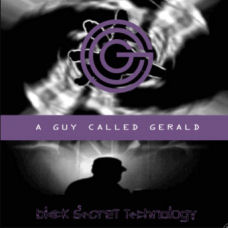 Received wisdom states that jungle brought about its own demise with its over-hasty coffee table gentrification (as symbolized by replacement genre name "drum'n'bass"), ushering in muso jazz and studio musicianship while draining the dancefloor energy that made the music vital in the first place. Of course, with drum'n'bass having spent more than a decade pounding "dancefloor energy" into an ideas-devoid mono-groove, it's worth examining whether the prior phase of decadent gentrification was really all its detractors claim it to be. Listening to Goldie's bloated 2xCD debut Timeless again, what irritates isn't the presence of noodling saxophones so much as the suspicion that Goldie thought it took a saxophone to make jungle epic. Orbital, with the clear vision sometimes gifted to outsiders, proved on their 1994 faux-jungle stab "Are We Here?" that the real possibility of the "epic" in jungle was hidden within the beat programming, offering up a broiling sea of slithering, snake-like drums. I like to think Orbital had been listening to A Guy Called Gerald (aka Gerald Simpson), who a year later released perhaps the only drum'n'bass album to successfully match gentrification with a consistent focus on "rhythmic danger." It's this, together with the album's scarcity, that has long made Black Secret Technology a much-touted candidate for "best jungle album ever." Previously, though, listeners had to imagine an ideal version of this music, squinting their ears to hear past the (diametrically flawed) murkiness or limp politeness of the mastering on the album's two prior releases. Thankfully, this new remaster of the original 1995 release achieves the best of both worlds, capturing the density of the original productions with a sharpness and force that was hitherto missing. Perhaps the greatest achievement of Black Secret Technology was to break so radically with many of his peers' presumption of an inverse relationship between rhythmic complexity and musical sophistication. Blending in with the class of 95's aspirational mood - albeit offering a more minimalist, Detroit-inspired take on it - Gerald laces his productions with soft-centred synth pads, slightly moody soulful diva soundbites, precariously wafting flute samples, and eerie strings. But all this remains a foil for the unrepentant, rumbling boom of the bass - and especially the beats. There is simply no other single-artist jungle album that pushes consciousness-altering beat programming as far, as fearlessly, as it is pushed here. Indeed, when it comes to rhythms this album is an embarrassment of riches. "The Reno" features cyborg drummers that seem to multiply before your eyes (or ears), the rhythm doubling over itself again and again while a diva cries "eeeh yeah-eh-eh-eh," all swirling with a viscosity reminiscent of DJ Pierre's "Wild Pitch" house sound. On "Survival", chattering time-stretched snares are progressively shattered into smaller and smaller pieces, until the groove resembles a fractured Cubist portrait of itself. On "Dreaming of You", snippets of hand-percussion seem to rise and curl around your eardrums like steam. Most amazingly, the ravished and ravishing "Cyberjazz" is possessed with convulsive shudders, beats fluttering with a stop-start nervous intensity that evokes a myriad of electric synapses flickering on and off. Gerald's approach to rhythm is almost decadent at times: frequently, painstakingly assembled interlocking layers of beats are placed almost on the edge of conscious awareness, or otherwise punchy rhythms become swallowed up in tidal swells of infra-red bass. On gorgeous reggae-jungle single "Finley's Rainbow" the astonishing, counter-intuitive beats rain down with murderous fury somewhere far off in the distance; the effect is like watching a thunderstorm over a distant bay, with only brief moments of being lashed by the hail and the lightning. At times this can be slightly frustrating; at others I'm reminded of that strange combination of harmony and headwreck that krautrockers Can concocted on Future Days (ironically or fittingly, Gerald's greatest ever attempt to toughen up his mindboggling mid-nineties aesthetic remains his remix of Can's "Tango Whiskeyman"). Like Can, Gerald understood that the division between "head music" and "body music" is false and unnecessary: Black Secret Technology achieves its sense of hypnotic drift through panoramic rhythmic compulsion, supplying a frictionless endorphin high that only comes with a massive expense of physical energy. Gentrification? More like a very noble savagery. [Reviewer: Tim Finney] |
|
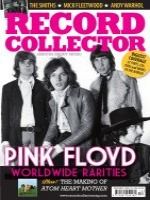 |
Record Collector Issue 356 December 2008 Link |
| A Guy Called Gerald Black Secret Technology A Guy Called Gerald / 01 Mid-90s high water mark brings voodoo magic 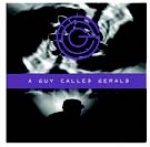 Manchester’s Gerald Simpson is one of the undisputed pioneers of UK electronic dance music, leaving the earliest line-up of 808 State to produce one of acid house’s biggest anthems with Voodoo Ray, the biggest-selling independent single of 1989, before laying down the template for the early 90s drum’n’bass uprising with his Juice Box label. A Guy Called Gerald’s tunes were distinguished by the man’s diligent homaging of roots stretching back to African rhythms, the musical depth of jazz mixed with the symphonic electronic soul of Detroit innovators such as Derrick May and his own brilliant visions. **** (4 stars out of 5) [Reviewer: Kris Needs] |
|
| XL8R 17th October 2008 Link |
|
A Guy Called Gerald Black Secret Technology Label: A Guy Called Gerald 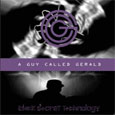 Thirteen years on and this album still sounds gorgeous. One of jungle's groundbreakers, A Guy Called Gerald's reputation would have been sealed with this album even if he never did another damned thing. Now he's remastered Black Secret Technology, which, happily, gives an excuse to listen to it again. The tracks here could all stand alone, but together, they comprise a masterpiece. The simultaneously soulful and sparse “Finley's Rainbow,” with vocalist Finley Quaye, was a stone classic then and will still be in 50 years; “Voodoo Rage” is shimmering and eerie. One of Gerald's greatest gifts is his ability to blend beauty and technology, to make something human and yet not human. If it's a secret, it's one he clearly knows. [Reviewer: Luciana Lopez] |
|
 |
Coke Machine Glow 17th October 2008 Link |
| A Guy Called Gerald Black Secret Technology (Juice Box/A Guy Called Gerald; 1995/2008) Rating: 94% 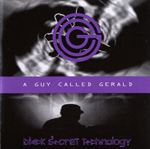 What is the value of futurism? It is an aesthetic escape route to a realm of humanity’s greatest hopes and fears; a land steeped in science fiction and looking to dystopia and utopia. It’s no mistake that futuristic novels and movies often imagine a society in which technology can provide ultimate measures of pleasure, but only in back alleys. This is a future where traditional diseases are no longer the problem, but an overpopulated society is suffocating on its growth, spurred on by an omnipotent and omniscient ruling presence. Futurism is a beautiful blue-lit room in which to passionately make love to a soulmate, in the middle of a rainstorm in the middle of a city racked with poverty in the middle of a regime hopelessly lost to the totalitarian madness of an insane few. Don’t laugh: futurism is the escape to beautiful new planets of infinite luxury and feelings so divine as to evade description. It’s the beautiful blinding endorphin of the soul. In Brave New World Alduous Huxley imagines such a paradoxical world, where the population is kept complacent by soma, a wonderful pleasure drug. I’d not be the first to attend to the potential parallel between soma in the brave new world and ecstasy in rave culture as it started with the second summer of love. I also won’t be the first to hypothesize that jungle represented a kind of come down, or at least a coming to senses. To a happy hardcore raver, the escapism ironically took a more depressing path, nuzzled in denial of the cold world outside the warehouse. But for the more cerebral junglists, starting point may have been the gutter but the destination was still the stars. (A Guy Called) Gerald Simpson and his contemporaries Goldie and 4 Hero knew that the world was harsh, but like true utopian futurists, sought a kind of positive refuge in art. And there’s Black Secret Technology. A Guy Called Gerald’s pedigree in making this kind of electric sunset-beautiful music can be traced back to 808 State’s breakthrough 1988 single "Pacific State," for which, it eventually came out, the then-departing Gerald wrote almost everything, leaving Graham Massey and Martin Price to provide a saxophone line and some mixing. Gerald’s contribution included one of the first and finest pad synthesizer riffs in ambient house, but certainly not the last he would produce. Flash forward a few years, and, following a brief but overly compromising flirtation with the majors, Gerald has gone deep underground. It’s the early 1990s, and jungle is a new, raw, and not-yet-commercial prospect, with Gerald as one of its more prodigious innovators. 28 Gun Bad Boy was the first album-length product of this period, a collection on Gerald’s own Juice Box label. Gerald updated his unmistakable brand of techno-soma with stomping breaks and Dickian paranoia. Listened to today, 28 Gun Bad Boy holds up well, much better than other early jungle experiments, but it’s still a prelude to the main event that followed. "does time work in rhythm…or does rhythm work in time. we have advanced to a level where we can control time solely by stretching of sound…we play with time." It’s odd to think of time-stretching as such a novel and futuristic technological achievement. Go to the club today (tonight) and the laptop DJ is performing time-stretching on multiple songs at the drop of a hat, creating seamless transitions and perfect mashups. Time-stretching is subtler now, too; where once the granular sound of a stretched sample was self-evident (as it is at multiple points on Black Secret Technology), today we have incredibly sophisticated algorithms for hiding the pockmarks of a messed-with sample. Pitch-shifting used to be this same kind of phenomenally new innovation, before the age of digital tuning applications so advanced it’s hard to tell which pop single uses it, and wisest to choose "all of them." It can’t just be because it’s 1995 that Gerald’s sample edits are so obvious. He’s sending a message here, playing with the machines rather than playing them, the most sacred respect for these processes being to leave them glaring on the record. Is it really futurism if we can’t assign it imperfections from the present? Check out "Finley’s Rainbow (Slow Motion Mix)." If "Pacific State" is Gerald’s most well-known pad, this one is hands-down his best. In just four repeating chords, we hear melancholy and euphoria, introspection as it results from the metamorphic social gatherings where all forms of electronic dance music have evolved. Flanked by sparse saxophone and rolling breaks, Finley Quaye croons Bob Marley’s "Sun Is Shining." This is no cover, but there’s a kindred vibe between Marley and Gerald. Both tracks emerged from frantic environments, and Gerald’s juxtaposition of peacefully slow descending synths cradle Quaye’s suggestions to step back for a while, up against the rushing breaks of society. That Marley was talking about modern pressures and Gerald applying a futuristic bent is the key contrast. The track begins with splashing water and a motherly voice, the latter stretched down to the point where it becomes an oscillating granular tail. I can’t tell what she’s saying, but it’s inviting and warm and comforting. Simple pleasures - a sunny day, bed at the end of hard work, a lover, family. Part of Black Secret Technology‘s otherworldly shine comes from its unusual production, in which the lower-mid and mid range - the pop of a bass drum and the slam of a crisp snare, namely - is neatly tucked away. This latest reissue finally features a decent remastering job; the original was the sort of butchery that gutted the bass from the equation. But even with the levels corrected, it’s the bass lines, mostly very low, that become apparent. Listening to opener "So Many Dreams," this style falls into place perfectly, as dream-like and ethereal as the material demands. Instead of chopping-block beats and snare rushes, we’re treated to phased and flanged out hi-end symbols, and shorter woodblock and rattle snares. Contrary to popular routes in mixing and mastering, the bass drums on Black Secret Technology are inclined to duck under the bass melodies. On some tracks, such as the beautiful Goldie collaboration "Energy," it’s hard to even tell if there’s really a separate bass drum and bass riff sound, contributing a certain midnight mystique to the music. The vocal work on Black Secret Technology further distinguishes the release, appearing mostly through layers of reverb and with a strongly gutted low-end. "Dreaming of You" positions this vocal production with that love-making respite I mentioned earlier, orgasmic gasps weaving in and out of the fold, before finally becoming part of the percussion. From another angle, "Dreaming of You" is chronicling the obsessive nature of a passionate relationship. Moving to melancholy, we’re presented with "Silent Cry," in which similarly detached female moans and cries enter as more of an instrument than vocals, occasionally layered and pitch-shifted out in a way that makes them hard to distinguish from a synthesizer. Turning once again to Gerald’s liner notes, there’s a suggestion as to what his silent cry is about: "the first man on earth […] developed a way of communicating which was to become an important part of his survival. these strange patterns of sound were called rhythm, rhythm then was not a leisurely thing, it was a way of life, methods of rhythm helped early man to get in touch with the universe and his small part in it…" Black Secret Technology, then, exists as a testament to Gerald’s struggle to understand, to connect, to feel something with tradition and individuality and nature in a world becoming increasingly interconnected, communal, and synthetic. As the liner notes continue, Gerald reflects, "i believe that some of these trance like rhythms reflect my frustration to know the truth about my ancestors who talked with drums." This kind of primal search for connection surfaces with "Voodoo Rage," in which Gerald revisits his first solo hit, "Voodoo Ray." In a sign of improving technology, the original 1989 acid house hit was meant to be titled "Voodoo Rage," but due to the time-length limitations of the sampler Gerald was using, the phrase got cut off as "Ray." Ironic, then, that improved sampling technology allows Gerald to forge deeper connections with the past and tradition. Using the same sample set as "Voodoo Ray," "Voodoo Rage" scraps the bouncy, Latin-tinged beats of the original for another foray into pad-laden techno breaks bliss. The titular sample is slowed down to show its grains, infusing the track with the kind of powerful energy Gerald was grasping for in his liners. Any classic album should have an epic closer, and Black Secret Technology does not disappoint. "Life Unfolds His Mystery" is the final scene in the futuristic scenario that Gerald has painted. The battle of human vs. artificial, individual vs. communal, real vs. fake is over, and it’s hard to say who’s won. The title of the album refers to a television program about secret government operations. As Simon Reynolds hypothesizes in Generation Ecstasy, an album so infused with futuristic technology yet named after a fear-inspiring aspect of that same technology illustrated the drum n’ bass conflict between the "pleasuredome" and "terrordome" potentials of an electronic world. By the time of "Life Unfolds His Mystery," Gerald appears set to revel in the pleasuredome, focusing his sharp rhythms against the sick infringements of the terrordome. "Such a beautiful…" declares a male singer. Spiritual celebration of life and its rhythms is what Gerald does best. It’s his form of protest, of celebration, of connection with the past, of contributing a reflection of his own soul to the continuum of descending order of aesthetic seekers. It’s not hard to understand why it took five years for Gerald to follow this up (with 2000’s Essence, another fantastic album in the same vein and well worth seeking out). Black Secret Technology isn’t a place to find answers, but more than ten years on it’s still one of the most engrossing, heartbreakingly beautiful, and defiantly hopeful and spiritual records I’ve spent time with. [Reviewer: David Abravanel] |
|
 |
Earplug (Issue 130) 25th September 2008 Link |
| A Guy Called Gerald Black Secret Technology A Reissue Long Overdue A Guy Called Gerald re-visits Black Secret Technology  Dance music's reissue culture gathers more steam this month with the highly welcome reappearance of British producer A Guy Called Gerald's Black Secret Technology on his own A Guy Called Gerald Music imprint. A brief, founding member of classic acid-house group 808 State, Gerald Simpson left the '80s outfit to record acid house, techno, jungle, downtempo, and acid on his own. His 1995 album Black Secret Technology was a jungle landmark; coiling writhing, ectoplasmic breakbeats around bassy detonations and radiant, fragrant sweeps of texture, BST reminds exactly how far out jungle went in its heyday. Featuring a co-production by Goldie, the record also boasts one of the earliest appearances on record by Finley Quaye. This reissue relies on Black Secret Technology's original tracklist - sans "Hekkle and Koch" or "Touch Me," the tunes which topped and tailed the Juice Box's 1997 edition - and features highly superior artwork. It all sits nicely alongside Simpson's recent collaboration with Berlin techno producer M.I.A. (of Sub Static fame), a leap from peripheral audition to 20/20 hearing that's a welcome turn indeed. [Reviewer: Jon Dale] |
|
 |
Boomkat July 2008 Link |
| A Guy Called Gerald Black Secret Technology (2008 Edition) A Guy Called Gerald AGCG01  Back in stock. Where to start with this album? Firstly, I should say that it ranks in my personal top 10 albums of all time and never fails to absolutely destroy me. Secondly - the abysmal sound quality of the original 1995 issue has now at long last been replaced by this brilliant new master - finally doing justice to the material and playable at loudest volumes imaginable - which we heartily encourage! 'Black Secret Technology' came out just before Goldie's 'Timeless' and was soon overshadowed by its commercial success, but Gerald's album remains a milestone in British electronic music and somehow sounds more relevant today than pretty much any Jungle/Drum & Bass album we can think of. Gerald brought together elements of Hardcore and Jungle with a melodic, evocative sound layering that could best be described as appropriating the chords and strings of Detroit techno. The resulting sound is both luxurious and oppressive, despite the harmonies it's a much less polished piece of work than Goldie's "timeless' and is somehow defined by that sonic dichotomy. The opening 'So Many Dreams' is both emotionally overwhelming and relentlessly cavernous - even the widescreen strings are squashed by brilliantly unstable production, the drums layered and impossibly intricate, the bassline nothing short of heartstopping. 'Energy' (interestingly co-produced with Goldie) is another indefinable piece of engineering, samples and vocals submerged by wonky synths and amazingly clever arrangements that leave you emotionally drained yet exhilarated. But it's tracks like 'Cybergen' that no one quite seemed to understand back in '95 that really leave you awestruck by this amazing album. It's a fierce, almost deranged alignment of grinding hoover noises and stripped drums in a proto 2-step formation that will absolutely destroy you when played loud - hard to overstate just how righteous it is. If you don't already own this landmark album - what the f*ck you waiting for???? Utterly Essential for all bass, drums and next-level fiends = every home should own a copy. [Reviewer: Unknown] |
|